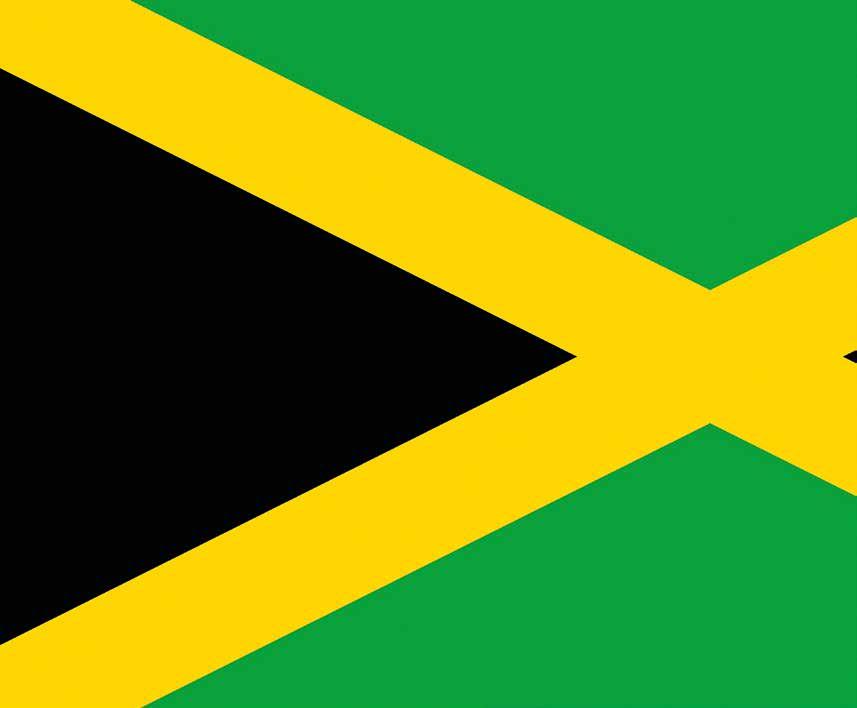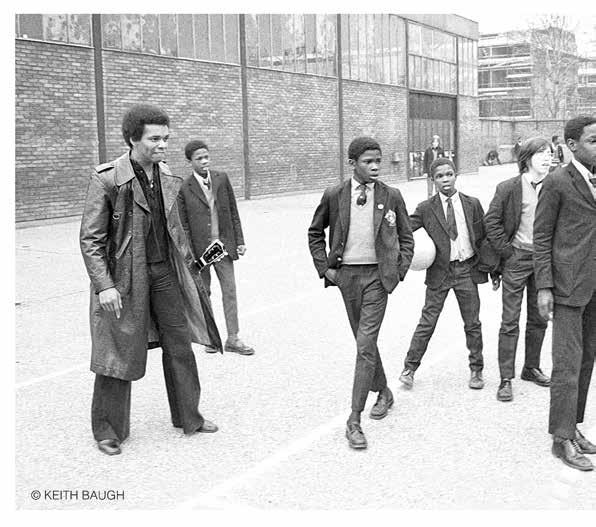
8 minute read
Why don’t you guys come down to the school in Peckham where I teach?
When Bob Marley played at Peckham Manor School

In March 1972, Bob Marley and Johnny Nash performed a free gig at a secondary school in south London (above) after a chance encounter with an art teacher in a central London nightclub. Ex-NUT member Keith Baugh tells Max Watson about his role in the making of a legend and how he found himself taking these iconic photographs.
Photos & words byKeith Baugh
When Bob Marley played at Peckham Manor School


In March 1972, Bob Marley and Johnny Nash performed a free gig at a secondary school in south London (above) after a chance encounter with an art teacher in a central London nightclub. Ex-NUT member Keith Baugh tells Max Watson about his role in the making of a legend and how he found himself taking these iconic photographs.
Towards the end of March 1972 I visited the Bag O’Nails nightclub off London’s Carnaby Street with my friend Martin who worked for CBS recording studios.
During the evening a couple of very cool dudes sauntered over and joined us at our table. Martin introduced me to the American singer Johnny Nash, who had just recorded an album at CBS, and then to Bob Marley who leaned over with a big smile and quietly said: “I just the songwriter.”
One of the album tracks recorded by Johnny was the Bob Marley song Stir It Up, which had been released as a single a couple of weeks earlier. The record was not selling well and both Johnny and Bob were clearly frustrated that the disc had not broken into the top 40, which would have automatically meant national radio and TV exposure.
Martin talked over publicity options with plans for interviews on local radio stations involving travel to far-flung parts of the UK, which didn’t seem to go down so well with the two musicians. It was at that moment I broke into the conversation and said: “Why don’t you guys come down to the school in Peckham where I teach and do an acoustic performance for the students? The school has a large games hall and you would have a target audience of a few hundred record-buying teenagers.”
Johnny said: “Yeah! that sounds cool.” Bob smiled and said: “Nice.” By the following day I had completely forgotten about the suggestion.
Two stools, no amps, no microphones
Three days later I had a telephone call saying that the gig was definitely on for Thursday morning and Martin would drive Johnny and Bob to Peckham Manor School by 10am.
I was asked to confirm that the school would agree to this. They would require a low stage with two stools, along with seating for as many students as possible. There would be two guitars, no amplifiers and no microphones. It was going to be a stripped-back acoustic gig.
The following morning I outlined plans to the head teacher who liked the idea of ‘famous’ CBS recording musicians visiting the school and approved students being off-timetable after morning break. It was all systems go and I kept my fingers crossed, hoping they would turn up.
continued on page 28
continued from page 27
Sure enough, they pulled into the school car park on time. As we walked to the games hall we passed a group of kids playing football. Bob smiled and, obviously aware of London’s football tribes, said: “Them all support Millwall? I support Tottenham Hotspur.”
“Probably best to keep that to yourself,” I replied and we laughed. A little later in the games hall coffee bar I chatted with Bob and Johnny as they tuned their acoustic guitars. Bob told me that he had written more than 400 songs. These included some of his most famous compositions soon to become huge international hits, including Sun is Shining, One Love, Don’t Rock My Boat, Kaya and Trenchtown Rock. I remember asking Bob if he rated Bob Dylan as a songwriter and he said: “Me like his songs about women,” and laughed. I mentioned Dylan’s Just Like a Woman, and he said: “Yeah, that’s the one.”
Johnny Nash’s ‘crystal clear voice’
Johnny and Bob entered the cavernous games hall space to a tumultuous explosion of clapping, foot stomping and cheering that took a good few minutes to subside.
Johnny introduced the first song, Hold Me Tight, saying it had got to number five in the UK and USA singles charts. A mesmerising and loping reggae beat emerged from the two guitars with Bob throwing in some exquisite lead guitar high up the neck and then Johnny Nash’s crystal clear voice filling the hall with the lyrics: “I don’t want to hear it, No more fussin’ and fightin’ baby.”
The song ended with raucous applause and Johnny followed with another hit song Cupid, his voice filling every corner of the vast space.
Bob Marley then looked over at Johnny and with a broad smile said this next song, Trenchtown Rock, was a number one hit for Bob Marley and the Wailers in Jamaica last year. There was huge applause, then Marley’s signature ‘chick-ee chick-ee’ reggae guitar set the groove followed by those unforgettable lyrics: “One good thing about music, when it hits you feel no pain.” The students were encouraged to join in with the final chorus.
ALTHOUGH a fabulous story, many would quite rightly question the authenticity of the event.
Fortunately, I had with me my old, battered 35mm Practica camera with 15 remaining frames of a Tri-X blackand-white film.
Guessing the light settings I got to take shots of the performance, a couple of unseen shots in the coffee bar and my favourite – this panoramic photograph of Bob and Johnny playing football in the playground.

Johnny then turned up the pressure with a sublime performance of his soon-to-be worldwide hit I Can See Clearly Now. The head whispered in my ear: “What a voice and what great role models these young men are for our students.”
Four more songs, including a shared vocal on Guava Jelly, took us up to a Q&A session.
The sun was always shining in Jamaica
The first question was: “What was it like to be in a recording studio?” Johnny replied that it was humbling to work with so many talented musicians, that you had to be focussed and well prepared and could not afford to waste time. Bob smiled and said that he preferred recording in Jamaican studios because the sun was always shining and between recording songs you could go outside and play football.
Of course the next question was aimed at Bob: “Which football team do you support?” After a long pause he gave a considered answer that pleased everyone: “Jamaica!”
Johnny was asked: “What car do you drive when you are in America?” The reply was, always a Cadillac. Finally, Bob was asked why he wore a hat indoors. He laughed and took off his striped beanie, letting his baby dreadlocks spring out. He said it was part of his religion and talked

Bob took off his beanie, letting his dreadlocks spring out, and explained it was part of his Rasta religion.
for a while about Rastafarian philosophy. The audience, however, wanted more music.
On to the final two songs. The first was the Marley song Reggae on Broadway, with the two singers sharing alternate verses. Everyone was invited to join in on the chorus and once more the games hall was filled with clapping and stomping and a joyous sound of two to three hundred voices.
A smiling Johnny Nash introduced the final song, the newly released single Stir It Up, with a request that the students encourage their brothers and sisters, aunts and uncles, cousins and friends to go out and buy the record and help get it into the top 40. Then once more Bob’s ‘chick-ee’ guitar introduction led into an extended and sublime version of the song.
Bob and Johnny spent 15 minutes signing photographs and then after coffee and donuts we walked through the playground.
Irresistible draw of playground footy
Bob saw a group of students playing football and could not resist getting involved (pictured below). The ball was passed to the singer and, with guitar in hand and the broadest smile, he demonstrated some exquisite ball control skills. After one of the most memorable mornings for everyone who witnessed the performance, the two musicians headed for the car and drove back to central London.
Having had a number of hit records Johnny Nash proved to be a consummate professional with real presence and an astounding voice. The relatively unknown Bob Marley was an exceptionally talented musician with an incredible self-confidence and a distinct aura around him. n As the performance took place decades before mobile phones, if you asked me to describe what it was like to hear Bob Marley in a unique situation like that, all I can do is ask you to listen to his acoustic version of Redemption Song at bit.ly/3fMf7sC
BOB Marley went on to global superstardom and his legacy and fame continue to grow almost 40 years after his death in 1981. I Can See Clearly Now was a worldwide hit for Johnny Nash by autumn 1972, reaching no 1 in the US billboard charts for four weeks. Johnny Nash is now retired.
Keith Baugh’s photography has been published in Rolling Stone magazine and elsewhere. In 1978 and 1981 he took ‘rolls of iconic shots’ of his hero Bob Dylan on tour, including a photo which Dylan chose for his 2017 album Trouble No More. Keith’s photos of New York’s underground graffiti scene are published in his book New York Subway Art 1973-1975, available from
keithbaugh.com
n See page 47 for a chance to win a signed copy of Keith’s book.












